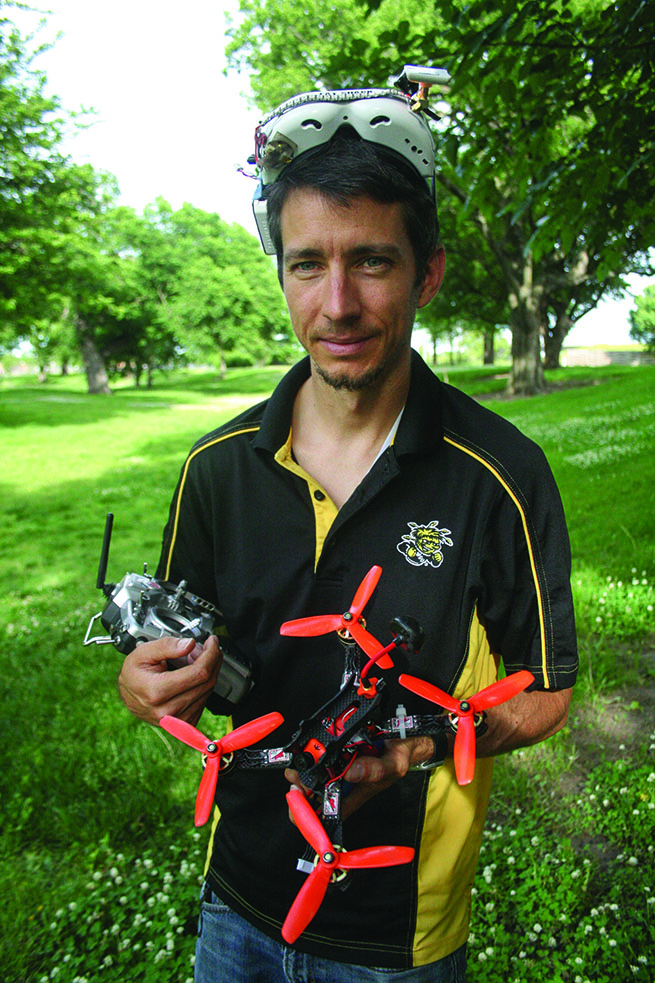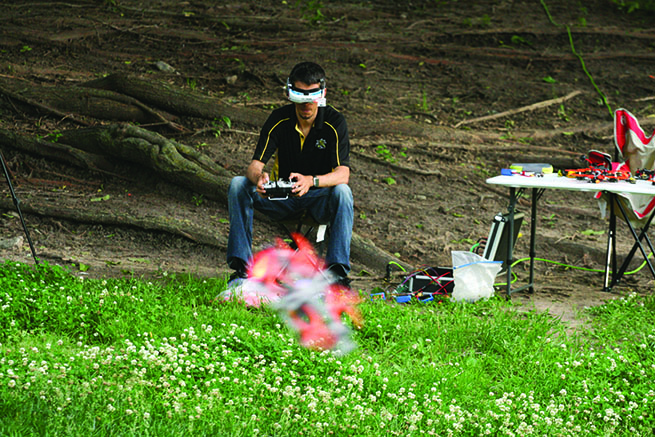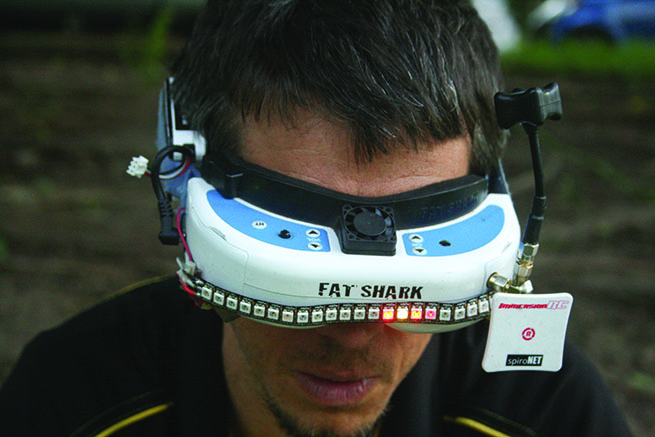
He slips on his camera-synched goggles, triggering the Top Gun theme song. Powering up his quad racer, he fingers the twin-toggled radio controls, and in the whisssssk of a split second the seasoned pilot — call sign BrainDrain — is whipping down the course inches above the weeds.
It’s just a narrow strip of a Wichita park, more like an overcrowded, tree-strewn gulch, but it’s where Brian Morris ’00 practices almost every evening after work.
The intense 38-year-old local IT professional is one of the best in the world at the arcane art and science of quad racing.
“This course has everything I’ve ever been to in a (race) course,” says Morris, a Wallace Scholar who graduated with a bachelor’s degree in aerospace engineering from Wichita State in 2000. “That tree right there, I fly over the top of it, I do a Split S and I go back underneath it. There’s hairpin curves. There’s slaloms. I got one, two, three, four, five, six trees in a row that I can slalom around. Everything you will ever run into in a course is right here.”
Morris is ranked second in the world by the International Drone Racing Association. He has logged a series of solid appearances over the past two years across America and overseas.
He won the 3-D FPV Championship Cup in France last year.
In March, he took second in the World Drone Prix in Dubai, United Arab Emirates, in a contest with a $1 million total purse. His team lost by just 12 seconds in a field of 69 competitors.
“The Dubai course is a four-million-dollar course with moving lights that followed the quad, and parts of the track moved also,” he says. “It was mostly fly over the top with a few gates, a pretty basic course for sure.” (Check out both the Dubai course and Morris’ home course on YouTube.)
He adds, “I’m just competitive. I’ve always wanted to be good at something. Here’s something I can be the best in the world at. I mean, how many opportunities will I have to be the best in the world at anything? Zero to one. Well, now I’ve got one. There’s not a single person out there that I go to the field and say, ‘I just can’t beat that guy.’ I know I have at least a chance.”
Right now, quad racing is not a spectator sport, and even Morris admits it’s “boring to watch.” That may change because of a multi-year broadcasting deal between the World Organization of Racing Drones and ESPN Sports in April.
Live coverage will start with the National Drone Racing Championships in NYC the first weekend in August.
His aircraft don’t look anything like the public’s idea of a drone, a term that he despises because of its militaristic connotations.
Morris’ hand-built racing quads have bare-bones carbon fiber CAD-cut frames, four fast-revving 32,000 RPM electrical motors smaller than a spool of thread, orange plastic tri-bladed propellers and lightweight strap-on batteries. The smallest will almost fit in the palm of his hand.
A tiny camera transmits the “cockpit” view to his Geordi La Forge-like visor, albeit a view that’s 12 feet behind where the quad is in real time when flying close to 80 MPH. Morris says his hand-crafted quads give him a big advantage, but other things, too, help win races.

— have carbon fiber CAD-cut frames, four 32,000 RPM electrical motors,
tri-bladed propellers and lightweight strap-on batteries. Ranked second in
the world by the International Drone Racing Association, Morris practices
in Wichita parks.
“There’s a lot of strategy involved,” he says. “One, not getting rattled by other racers. Two, as you’re flying, keeping track of points. As you learn what points you have, you decide whether to push it or not. And don’t panic. Keep your cool.”
He’s obsessively competitive. “Life is so short. You’ve got to do everything right now. If I can be Number One, I’m going to be Number One right now,” he says. “Because I know tomorrow something will go snap, and that’s the end. You’re done and you’re over with. So put everything in that you can while you can.”
Morris follows a strict routine. After a day of building servers, integrating digital printing presses and fixing work stations at McCormick Armstrong in Wichita, where he has worked since graduation, he drives less than a mile to his house, grabs a bite to eat, walks across the street and is set to fly by 5:15 p.m.
In the gaps between people and dogs crossing the park, Morris fires up flight after flight, his hands tweaking the controls and the props making a screaming killer bee moan in four-part harmony until dark.
Morris chuckles at his newfound notoriety. “Until Dubai, none of them, I don’t think they knew. ‘He’s just screwing around,’ ” he explains. “The (neighbor) guy comes out and he’s like, ‘Oh my gosh, I had no idea.’ Because I was telling him, like, ‘Yeah, I’m like top in the world.’ And he was like, ‘Whatever, whatever.’ And then he watched the Dubai tape, and he was like, ‘Oh my gosh, you really are.’ And I was like ‘Yeah, I was not playing around.’ ”
His competitors may only practice every two or three days. That only makes Morris practice harder.
“This is how I got so good,” he explains. “This is the reason why I’m up there. Because if I have even an extra 30 minutes, I can come out here and fly four batteries (worth). Most of the other racers, they’re packing up everything, they’re driving to the field, unpacking everything and so that’s not an everyday thing for them.”
Having a practice spot across the street from his house adds hours of experience. “Now I can fly wherever I want, as fast as I want, with zero repercussions generally, minus when I get stuck in a tree and I have to climb the tree and have to spend the next four hours of my life shaking it out of the tree. So I can get that flight every day.”
Like most kids, Morris was into computers and video games growing up in Goddard, Kan. Things got more intense when he got to Wichita State and developed the research and design skills that help him to this day.
“It was the engineering degree,” says Morris, who lacks a pilot’s license but always wanted to be in the cockpit. “Engineering made me want to understand everything — How. It. Works. I understand Reynold’s numbers. I understand flow. I understand drag. I understand stress. I understand moment arms. I understand all the basic functionality.
“So I have all this education from WSU that really helps me understand, and a lot of the other guys are just, you know, maybe you’ve got a car tire salesman or someone like that, and he doesn’t really know anything about electrons, he doesn’t know anything about carbon fiber. So he just puts together whatever. We put together the top of the top performance quads. Anywhere I go my quads are in the top one percent of performance,” Morris says.
His favorite engineering professor was Dr. Scott Miller, now chair of aerospace engineering. “He was one of the coolest teachers; he had an interest in cool stuff.
He did the kinds of things that I liked,” Morris says. The feeling was mutual.

manufacturing company based in Brussels, Belgium,
sponsors Brian Morris’ quad racing activities, which
have taken him across the land and around the world,
most recently to Dubai, UAE.
Miller, whose research interests include experimental aerodynamics, aircraft design and rotor aerodynamics and who also serves as director of the NASA in Kansas program, remembers Morris as a good student “who sort of had a laid-back California feel to him. I wouldn’t necessarily put him in the full-blown engineering nerd stereotype, but he was certainly a hard worker. He liked to have fun, too. He was one of those guys who liked to do things, not sit around and run calculations. He was interested in lots of things. He didn’t want to follow the standard model of doing things.”
Last year, Morris let his former teacher strap on a spare pair of goggles at Chapin Dog Park, another place he flies timed runs. “I sat down on a bench,” Miller recalls. “He gave me a ride that was pretty wild. He was flying through gates and turning all the time. It was fun.”
For Morris, though, it hasn’t always been fun times. For years, he has battled gastrointestinal problems that sap him of energy and for a time had him at death’s door. He calls those his “Dead on the Couch” years, when just going to work was exhausting.
He still feels ill, but now Morris relies on members of his traveling team to assist while he flies for his sponsor, Sky-Hero, a young drone airframe and hardware manufacturer headquartered in Brussels, Belgium.
His team includes Kalyn Doerr, who lives in Wichita and whose quad racing name is rs2k. No one is more important than his girlfriend of three years, Christy Vavra, who teaches 7th grade science at Haysville West Middle School.
“I do not survive without Christy. She can build quads. She goes to the events. She gets up one to two hours before everyone else, drives all over, and cooks special meals for me,” Morris says. “She gets to travel all over but she works. She has been just awesome. She has taken on this support role that is just insane. I would not be here without her. She takes off time to help me. She takes that pressure off.”
He is also hyper aware that in a sport where 15-year-olds are tearing up the courses, his days of leading the pack are numbered. “I’m riding it while the kids aren’t here,” Morris says. “I figure I have a year, two years, and those kids take over and I can find another role. I can be a coach. I can manage a team. I can go back to (flying) helicopters. I can do whatever I want.
“But right now is my time. I can beat anybody.”





